
Colchicum is a genus of perennial flowering plants containing around 160 species which grow from bulb-like corms. It is a member of the botanical family Colchicaceae, and is native to West Asia, Europe, parts of the Mediterranean coast, down the East African coast to South Africa and the Western Cape. In this genus, the ovary of the flower is underground. As a consequence, the styles are extremely long in proportion, often more than 10 cm (4 in). All species in the genus are toxic.

Anthemis is a genus of aromatic flowering plants in the family Asteraceae, closely related to Chamaemelum, and like that genus, known by the common name chamomile; some species are also called dog-fennel or mayweed. Anthemis are native to the Mediterranean region and southwest Asia east to Iran. A number of species have also become naturalized in the United Kingdom and other parts of the world.

Teucrium is a cosmopolitan genus of flowering plants in the family Lamiaceae, commonly known as germanders. Plants in this genus are perennial herbs or shrubs, with branches that are more or less square in cross-section, leaves arranged in opposite pairs, and flowers arranged in thyrses, the corolla with mostly white to cream-coloured, lobed petals.

Teucrium scorodonia, common name the woodland germander or wood sage, is a species of flowering plant in the genus Teucrium of the family Lamiaceae. It is native to Western Europe and Tunisia, but cultivated in many places as an ornamental plant in gardens, and naturalized in several regions.
Umbilicus chloranthus is a species of flowering plant in the Crassulaceae family. It is referred to by the common names green Venus' navel and ombelico di Venere verdastro. It is native to Albania, the East Aegean Islands, Greece, Turkey, and Yugoslavia.
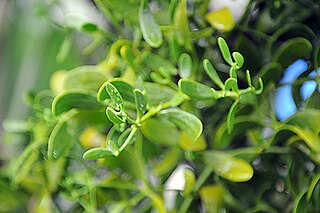
Viscum cruciatum, commonly called the red-berry mistletoe, is a species of mistletoe in the family Santalaceae. It is native to Lebanon, Morocco, Palestine, Portugal, Spain, and Syria.
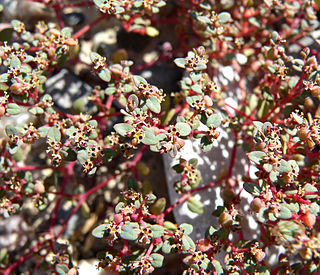
Euphorbia micromera is a species of flowering plant in the family Euphorbiaceae. It is known by the common name Sonoran sandmat. It is native to the southwestern United States from California to Texas, and northern Mexico, where it grows in sandy soils in desert and other dry habitat. It is an annual herb forming a small mat of slender stems. The hairy to hairless leaves are oblong in shape and just a few millimeters long. The tiny inflorescence is a cyathium less than a millimeter wide. It lacks the appendages that many similar species have in their cyathia. It has only a central female flower and 2 to 5 male flowers surrounded by round red nectar glands. The fruit is a minute round capsule.
Euphorbia remyi is a rare species of flowering plant in the family Euphorbiaceae. It is known by the common name Remy's sandmat locally as ʻakoko. It is endemic to the island of Kauaʻi in Hawaii, where it grows in mixed mesic forests, wet forests and bogs from 150 to 900 m.

Acer heldreichii is a species of maple in the flowering plant family Sapindaceae. Commonly called Balkan maple, Greek maple, Heldreich's maple, or mountain maple the species is native to Albania, Bulgaria, Greece, North Macedonia, Montenegro, Serbia, and Bosnia-Herzegovina.
Adonis cyllenea is a species of flowering plant in the family Ranunculaceae. It is endemic to Greece.
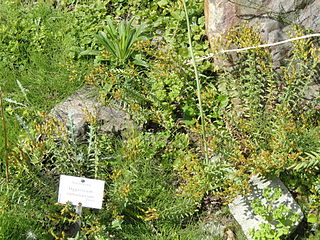
Hypericum rumeliacum is a species of flowering plant in the family Hypericaceae, native to southeastern Europe.

Bosea cypria is a species of flowering plant in the Amaranthaceae family. It is a highly branched, evergreen shrub, 1–2 m high, erect, suberect, or hanging on walls, cliffs or trees, with hairless angular shoots. Leaves, opposite, simple, entire-+ elliptical, 2-6 x (1-2-3) cm, hairless, petiolate, dark green, occasionally red green. Flowers in branched spikes, hermaphrodite or unisexual 5-merous, very small, green brown, the floral symmetry is actionomorphic. The fruit is a globose red berry. Flowers from April to July. It is endemic to Cyprus and in the local Greek Cypriot dialect it is called ζουλατζιά

Allium sindjarense is a species of flowering plant in the Amaryllidaceae family.

Armeria duriaei is a flowering plant in the family Plumbaginaceae. It is endemic to mountains of north-western Spain and adjacent regions of Portugal. Its flowers are usually pink, or rarely white.
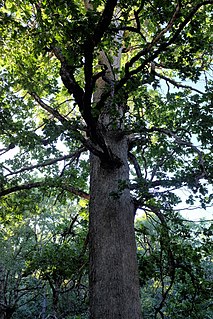
Quercus vulcanica is a species of flowering plant in the Fagaceae family. It is referred to by the common name Kasnak oak, and is a rare species of tree native to Lebanon, Syria, and Turkey.
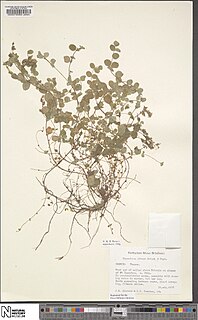
Hypericum athoum is a perennial herb in the Hypericaceae family. It is endemic to Greece.
Hypericum pubescens is a perennial herb in the Hypericaceae family. It is in the section Adenosepalum.

Hypericum sect. Adenosepalum is one of 36 sections in the genus Hypericum. Its type species is Hypericum montanum.

Aquilegia ottonis is a species of flowering plant in the buttercup family. It has a broad distribution in Europe; it is native to Greece, Italy, and Albania. Plants produce blue-purple flowers which, based on pollination syndromes, are thought to be pollinated by bumblebees. A. ottonis is named after King Otto of Greece; the specific epithet 'ottonis' is the third declension of 'otto'.















